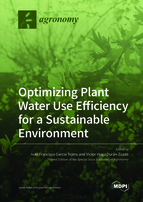Optimizing Plant Water Use Efficiency for a Sustainable Environment
A special issue of Agronomy (ISSN 2073-4395). This special issue belongs to the section "Water Use and Irrigation".
Deadline for manuscript submissions: closed (31 December 2020) | Viewed by 63074
Special Issue Editors
Interests: water stress; crop physiology; deficit-irrigation strategies; crop-water monitoring; soil conservation; conservation agriculture
Special Issues, Collections and Topics in MDPI journals
Interests: water stress; crop physiology; deficit-irrigation strategies; crop-water monitoring; soil conservation; conservation agriculture
Special Issues, Collections and Topics in MDPI journals
Special Issue Information
Dear Colleagues,
We are pleased to present this Special Issue focused on the most remarkable research experiences about water use efficiency in agriculture, specially under semi-arid conditions and Climate Change scenarios.
Water scarcity is the most limiting constraint in agriculture, together with the soil degradation and the imbalance between sustainability, competitiveness and food demand. In this agreement it is worth to deepen about those strategies and production systems able to reach competitive yields, enhancing the quality of products, preserving the food security, and all of them, within an equilibrium in environmental terms.
Implementing new tools to assess the crop water status, monitoring the continuous soil-plant-atmosphere system, or integrating information systems based on big-data and smart farming tools will reinforce the actual knowledge to offer an appropriate response to the actual challenges to achieve a higher water use efficiency in irrigated and rainfed systems. Moreover, the introduction of resilient crops to water scarcity scenarios or the strengthening of sustainable practices of water resources management will enhance the consolidation of rural population, the agricultural competitiveness and the environmental sustainability.
Dr. Ivan Francisco Garcia Tejero
Dr. Victor Hugo Durán-Zuazo
Guest Editors
Manuscript Submission Information
Manuscripts should be submitted online at www.mdpi.com by registering and logging in to this website. Once you are registered, click here to go to the submission form. Manuscripts can be submitted until the deadline. All submissions that pass pre-check are peer-reviewed. Accepted papers will be published continuously in the journal (as soon as accepted) and will be listed together on the special issue website. Research articles, review articles as well as short communications are invited. For planned papers, a title and short abstract (about 100 words) can be sent to the Editorial Office for announcement on this website.
Submitted manuscripts should not have been published previously, nor be under consideration for publication elsewhere (except conference proceedings papers). All manuscripts are thoroughly refereed through a single-blind peer-review process. A guide for authors and other relevant information for submission of manuscripts is available on the Instructions for Authors page. Agronomy is an international peer-reviewed open access monthly journal published by MDPI.
Please visit the Instructions for Authors page before submitting a manuscript. The Article Processing Charge (APC) for publication in this open access journal is 2600 CHF (Swiss Francs). Submitted papers should be well formatted and use good English. Authors may use MDPI's English editing service prior to publication or during author revisions.
Keywords
- deficit-irrigation
- crop-water requirements
- smart farming
- crop-production functions
- food quality
- remote sensing
- crop physiological response to drought scenarios






